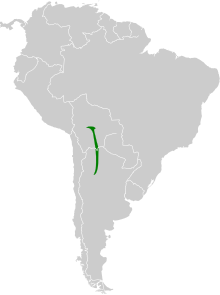Red-bearded star hummingbird
| Red-bearded star hummingbird | ||||||||||
|---|---|---|---|---|---|---|---|---|---|---|

Red-bearded star hummingbird ♂ (picture that Burmeister had sent to Sclater) |
||||||||||
| Systematics | ||||||||||
|
||||||||||
| Scientific name of the genus | ||||||||||
| Microstilbon | ||||||||||
| Todd , 1913 | ||||||||||
| Scientific name of the species | ||||||||||
| Microstilbon burmeisteri | ||||||||||
| ( Sclater, PL , 1888) |
The Slender-Tailed Woodstar ( Microstilbon burmeisteri ) or Burmeisterkolibri is a apodiformes in the family of hummingbirds (Trochilidae). It occurs in the South American countries Bolivia and Argentina . The IUCN classifies the population as Least Concern .
features
The red bearded star hummingbird reaches a body length of about 7 to 9 cm, depending on the length of its tail. The slightly curved beak makes about 15 mm. The upper side is bronze green in both sexes. The reddish purple color of the male's throat extends over the ear area. The underside is light gray with bronze green sides. The rump is cinnamon in color. The approx. 3 cm two-lobed tail consists of two outer control feathers . In the plain dress, the male's throat is pale. The female has dark cheeks with a white line behind the eyes. The yellow-brown underside has a white spot on the rump side. The short, cinnamon-colored, right-angled tail is crossed by a dark, thin band. The central control springs are also dark.
Fledglings are similar to adults but have a striped top. In the male, about a third of the tail feathers are black.
distribution and habitat
They live on slopes and in ravines with bushes. Here you can find them in the thicket and thorny scrub overgrown with creepers. They often sit on deciduous trees at heights between 1,600 and 2,600 meters. Its distribution area extends from Tintin in the Carrasco National Park to the Cochabamba department in Bolivia and the Catamarca province in Argentina.
behavior
Not much is known about their behavior so far.
Vocalizations
Your call sounds like a quiet clock or Tthrrr .
Etymology and history of research
Philip Lutley Sclater first described the red- bearded star hummingbird under the name Chætocercus burmeisteri . It was not until 1913 that Walter Edmond Clyde Todd added it to the Microstilbon genus . However, at this point he did not realize that the species had already been described by Sclater. The synonym Microstilbon insperatus also exists . The hummingbird is the only one of its kind.
The term »Microstilbon« is derived from the Greek words » mikros , μικρος « for »small« and »stilbōn, στιλβων « for »sparkle, glitter«. The Greeks gave Mercury the nickname Stilbon, which can be traced back to the verb »stilbō, στιλβω « for »blink«.
The specific epithet was awarded in honor of Hermann Burmeister (1807-1892). He had sent Sclater a water color picture of the type specimen from the Museo Argentino de Ciencias Naturales Bernardino Rivadavia . After Sclater had sought advice from Osbert Salvin and Count Hans von Berlepsch , he came to the conclusion that this was a new species.
literature
- Jon Fjeldså , Niels Krabbe : Birds of the High Andes: A Manual to the Birds of the Temperate Zone of the Andes and Patagonia, South America . Apollo Books, Stenstrup 1990, ISBN 87-88757-16-1 .
- James A. Jobling: A Dictionary of Scientific Bird Names . Oxford University Press, Oxford 1991, ISBN 978-0-19-854634-4 .
- Philip Lutley Sclater: Mr. Sclater read the following description of a supposed new Humming-bird of genus Chætocercus, contained in a letter received from Dr. H. Burmeister, FMZS . In: Proceedings of the Zoological Society of London . No. 4 , 1887, p. 638-639 ( online [accessed February 27, 2012]).
- Walter Edmond Clyde Todd: Preliminary diagnoses of apparently new birds from tropical America . In: Proceedings of the Biological Society of Washington . tape 26 , 1913, pp. 169-174 ( online [accessed February 27, 2012]).
Web links
- Microstilbon burmeisteri inthe IUCN Red List of Endangered Species 2011.2. Listed by: BirdLife International, 2009. Retrieved January 21, 2012.
- BirdLife International: Species Factsheet - Slender-tailed Woodstar ( Microstilbon burmeisteri ) . Retrieved January 21, 2012.
- Videos, photos and sound recordings of Slender-tailed Woodstar (Microstilbon burmeisteri) in the Internet Bird Collection
- Red Bearded Star Hummingbird ( Microstilbon burmeisteri ) at Avibase; Retrieved January 21, 2012.
- Microstilbon burmeisteri in the Integrated Taxonomic Information System (ITIS). Retrieved January 21, 2012.
- xeno-canto: Sound recordings - Slender-tailed Woodstar ( Microstilbon burmeisteri )
